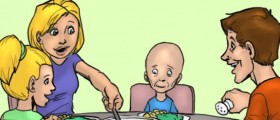
Overview Of Down Syndrome
Down syndrome is a genetic disorder that affects 1 in every 800 births in North America. Down syndrome is the most common genetic conditions whose symptoms are present right at birth, and the most prominent cause of cognitive disability. The disorder was first recognized in mid-19th century when a physician named Down noticed the resemblance of physical and mental anomalies that run in families. About 100 years later Jacobs and Lejeune identified the genetic components that make up Down syndrome and described the chromosomal characteristics of persons affected by the condition.Down Syndrome And Bone Development
Down syndrome is characterized by a number of different symptoms, some that define the physical appearance of the patient and others that determine the mental capabilities. When it comes to the physical growth and bone development, individuals affected by the syndrome grow at a much slower pace than average persons from the general population. Developmental milestones are reached at different times, while the full capacity of a Down syndrome person remains limited compared to non Down syndrome peers. For instance, affected persons are short in stature and often develop obesity sometime during puberty. The skull is never fully formed and its development is coupled by various barriers. Sloping foreheads, sinus defects, microcephaly, brachycephalic, and similar characteristics distinguish the skulls. The mouth and teeth are also substantially affected. The lips are often very full while the tongue is abnormally long. Down syndrome persons tend to drool and have chapped lips. The teeth are often decaying, as there are larger amounts of saliva in Down syndrome people, which allow the bacteria to deform the teeth. Patients often have small necks and malformed ears. Hearing problems are commonly observed, as the middle ear is disfigured and often full of excess liquid. Numerous vision problems are present as well. More than 50 percent of affected persons will have some form of vision impairment.Hands And Feet In Down Syndrome
Hand and feet of Down syndrome individuals are different from those of the non-disabled persons. When it comes to the hands, there is usually only one crease across the palm. Their finders are short and chubby, and the small finger is often turned inward. In the case of feet, they are also small and the space between the big and the next toe is wider than usual. These physical characteristics are of no medical importance other than to help in making diagnoses based on a physical exam when children are born.Other Developmental Problems
Aside from the physical features, Down syndrome also produces numerous other anomalies. For instance, individuals with the condition often suffer from mild to severe mental retardation sometimes with a much lower than normal IQ. Nevertheless, regardless of how limited their potential may be, these persons should not be compared to children from the general population as their developmental paths are different. Further, Down syndrome persons are capable of learning new things, acquiring skills, and accumulating knowledge throughout their lives. It is important that the parents and caregivers provide the right educational opportunities and their Down syndrome child could grow up being an independent adult. When it comes to the behavior of such persons they are highly capable to interpreting emotions and are generally genuine, patient, spontaneous, and tolerable. It should be noted that the spectrum of personality traits among Down syndrome individuals is just as wide as it is among the general public. In addition to the cognitive issues, sleep problems are often observed as well. Sleep apnea due to deformed sinuses is one of the most commonly seen ones, and so is insomnia. Seizures are also sometimes reported. Different forms of epileptic fits are seen in children and adults. Lastly, persons suffering from the condition are known to age prematurely. Their hair will gray and eyes will develop cataracts In some cases they’ll develop dementia or Alzheimer’s disease.Causes of Down Syndrome
It is known that the condition is genetic, and the pattern of inheritance is fairly clear. The chromosomal differences have been identified and explained but the root causes of the disorders are still unknown. Individuals with Down syndrome inherit extra genetic material at conception. Persons who develop normally have 46 chromosomes, 23 from the mother, and 23 from the father. Down syndrome people inherit one additional chromosome 21 or some of its genetic material, totaling 47 chromosomes. The additional genetic material affects almost every part of the body and leads to a wide array of problems. As is the case with any other genetic condition, the parents do not have to have any symptoms themselves, they just need to be the carriers of the disorder. As there are rarely any signs of the malfunctioning genes in the carriers they are usually unaware of the fact that they could pass on defective genetic material to their offspring.
















Your thoughts on this
Loading...